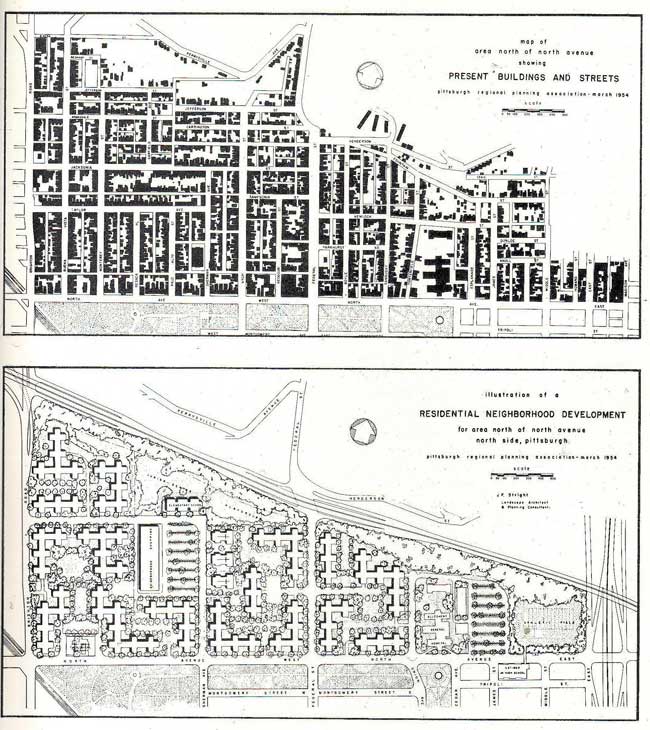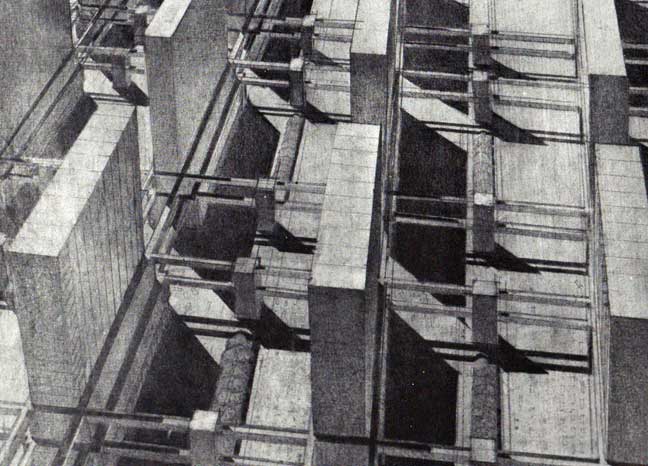

152 modernism
This is a plan, one of thousands produced in postwar America, for the
annihilation and reconstruction of an 'obsolete' urban neighborhood, in
this case the part of North Side Pittsburgh north of Allegheny
Commons. In this case, happily, the plans were never realized, and this
area, known as the Mexican War Streets, soon after became one of the
nation's first and most encouraging examples of spontaneous renewal,
with no guidance or help from government. Today it's one of the city's
more desirable residential areas.
We must kill the street. America in 1920 seemed to have finally settled on a general form for its city-building, based on a complex and satisfying manner of eclectic architecture, and a 'suburban' system of separate commercial and residential streets. Back in Europe, still in intellectual turmoil after the ordeal of the Great War, the highbrows were cooking up something entirely different. Architecture was meant to bring order, they believed, as it had once in Athens or Rome or Paris. This new machine age, with its infinite possibilities, needed to find a new and universal style to express itself. The reaction against eclecticism that broke out in that decade would come from many architects and many writers, but all found common ground in an ideal of puritan simplicity, expressed in mass-production methods and machine-made components. The same fastidiously geometrical daemon that inspired our National Grid must have had a hand in it too, for never had the right angle been worshipped so fervently. And never before had a mere style in architecture puffed itself up to the status of a faith. Along with the right angles, its practitioners were peddling a vision of a new society, an ultra-rational utopia where the forms and hierarchies of industrial organization would be mirrored in every aspect of life. The faith marched to slogans: 'Less is More!', 'Ornament is Crime!', and it found a world-class publicist in the person of a young and intense Swiss architect named Jeanneret, who for reasons not entirely clear called himself Le Corbusier. Jeanneret had a close call with the modern world in 1924, when a motorcar nearly flattened him on the Champs-Elysées. In his account of the event, he muses nostalgically on how the 'streets once belonged to us', and then, in a sudden, typically modern flash of contradiction, he decides to throw in his lot entirely with the invaders: 'One is seized, filled with enthusiasm, with joy...the joy of power... One has confidence in this new society; it will find a magnificent expression of its power. One believes in it.' Before long, this new allegiance turned into a crusade. For a manifesto, Corbusier gave the world his provocative Voisin Project for Paris, a plan to raze most of the historic city to the ground and replace it with geometrical ranks of identical 500-foot towers connected by high-speed highways. He decorated his writings with photos of machines, cars and American grain elevators as icons of a new aesthetic, supported with such cryptic epigrams as 'The building that achieves speed will achieve success'. Corbusier's new architecture was called Purism, and it would be the first 'total architecture', an attempt to reorder and redefine human life and society in the image of the machine. Corbusier had seen what the automobile was doing to city streets, and he decided to help it along. He had a strange compulsion about the subject, as if there was something unhealthy about citizens looking each other in the eye, or conversing as they passed on the sidewalk. 'Streets are an obsolete notion', he declared, 'There ought not to be such a thing as streets.' As in the Voisin Project, his plans confined all human activities—work, play, home, commerce—into his giant towers. The space in between would be all parkland, cut through by motor roads. The street would cease to exist. What was so important about the street? Corbusier was coy about it all through Towards a New Architecture, but he gives away the game in the portentous last words of the book: 'Architecture or Revolution. Revolution can be Avoided.' The street and the public square were symbols of the people; they belonged to everybody. Outside the well-policed discipline of factory and office, they were places the scientific-industrial order could not control. They were dangerous to it. How the utopian could turn so rapidly into the totalitarian may be the great mystery of the receding, unlamented century of troubles into which we were born. After the Great War, totalitarian systems were all the rage. Each had its body of faith, though all their tiresome manifestos were mostly window dressing. More important was what each had in common—as George Orwell understood it rightly, the subjection and control of nations by a small cadre of intellectuals. People had formed totalitarian systems out of the flimsiest ideals; why not architecture? Thus the communists and the architects followed the same trajectory, and it would be in the totalitarian lands, specifically in the new towns and suburbs of the Soviet Union, that Le Corbusier's ideas found their biggest welcome. The point of the Modernist mania for wiping out all traces of the past would be explored later, in the works of Orwell and Aldous Huxley and Ray Bradbury. The vision of a totalitarian society enslaved by the buildings in which it lived was Le Corbusier's own. Home would be a standard numbered flat in a standard numbered tower. Eerily echoing contemporary New York planners' vision of the city as a 'machine for production', home would be a 'machine for living'. The new architecture was compared to the Baroque in its boldness, its treatment of space and its celebration of scientism's triumph—this time not only over nature, but over the individual: the architecture of the superman. Our fond old sampler of historically-inspired architecture could hardly compete. In an age when everyone was looking for the merging of science and life through all-encompassing systems, the old architecture had none to offer. Even the classical public buildings of the City Beautiful, understood by a previous generation as symbols of democracy and civic virtue, were now condemned as hopelessly backward, even 'reactionary'. To the mass mind enthralled by systems, these ideals meant little. The new ideology never exactly captivated the public with its austere white boxes, but academia proved easier to impress. In the 30's, a wave of architects and designers associated with the movement that was already calling itself the 'International Style' came to America as refugees from Hitler. Walter Gropius became the dean of architecture at Harvard, Mies van der Rohe at the new Illinois Institute of Technology, on a bleak campus he designed himself. These two former directors of the Bauhaus in Dessau led a remarkably quick transformation in teaching, in which the dogmas and practices of Modernism took hold of every architectural school in the land. Not all of these men followed Le Corbusier's satanic obsession with technocracy and social control, but all shared his ideal of 'purity', his talent for self-promotion, and above all his penchant for obscure verbiage and sloganeering. There is always a bit of peacock in every architect. Now, the new men were calling themselves 'master builders of the total environment'. Tom Wolfe's colorful rant From Bauhaus to Our House got it exactly right. Few clients ever admitted liking Modernist boxes, but they acquiesced when academics told them they ought to like them. The wonder is, how a powerful and supremely confident young nation could fall so heavily for an alien style completely at odds with its aspirations and traditions. Modernism's ideology was so radical, and its triumph so overwhelming, that the evolution of our native Art Deco was nipped in the bud; a succeeding generation of critics would ignore its works completely, as if they found the Chrysler Building a national embarrassment. Read most books on architecture written in the postwar decades, and it will seem as if the brilliant 1920's in America never existed. For urban design, the most long-lasting and damaging effect of Modernist hubris was to teach architects that the siting of a building didn't matter. Edmund Bacon, in Design of Cities, called it the 'Great Amputation', the manner in which Le Corbusier divorced buildings from the land on which they stood. Bacon, writing in the 60's, had to be quite careful about this subject; any outright condemnation of Le Corbusier would have brought down the full wrath of academia, which counted for something in those days. '...His place in history is invulnerable', he writes of the little Switzer; one gets the impression he would have liked to say things that can only be said openly now. The Modernists came to see each building as an independent unit, not only a 'machine for living', but a complete and self-contained work of art in itself, like a sculpture. The building's placement could be totally arbitrary, and the question of its relation to the fabric of the city was never addressed—not surprisingly, as the Modernists' intent was to sweep the old city away entirely, as an outmoded relic of the past. Only thirty years after Burnham and his generation revived the art of urban design in America, it was cast aside once more. The new ideology claimed to refound it, throwing out all the experience of the past in favor of two iron rules. First, the superblock, a large plot of ground where interior streets disappeared. On it, people would live in rectangular slabs, preferably identical, and placed in geometric arrays. The ideal could be seen in its purest form in the work of Austrian emigré Richard Neutra, who built white hilltop mansions for the elite in Los Angeles while he formulated his future fantasy in Rush City Reformed (1928), a spectral science-fiction city that takes the Corbusian ideal to heights of robotic horror. Outside the campuses, Modernists got little chance to build in the 30's and 40's, but as things got back to normal after the war they would be able to impose their style on just about everything except privately-built housing. Modernism found its home in the skyscrapers downtown, where it became the architecture of the Organization Man. It started innocently, often delightfully, in the early 50's with such buildings as Lever House in Manhattan. By the 70's they were sprouting up everywhere, turning downtown skylines into rows of lookalike glass and metal boxes. Not the least of Modernism's ironies was the service it rendered to speculative developers-cheapness was in fashion, as 'less is more' became a handy excuse for a drastic lowering of architectural standards. The results can be seen in any city that had an office-space boom in this period, as in the cheerless canyons around Sixth Avenue, memorably described by Norman Mailer as the 'empty landscapes of psychosis'. Low standards suited governments fine too; New Orleans and Detroit, among others, built Modernist city halls that they now thoroughly regret; New Orleanians are already considering demolishing theirs. In residential building, Modernism became an excuse for a parallel collapse in quality and standards. The staples of postwar building, the stripped-down ranch house or the aluminum-sided bungalow, always described in real-estate brochures as 'neat as a pin', are part of the Modernist heritage too, even if serious architects would deplore the fake shutters and the peaked roofs (they would give their own clients flat ones, doomed to leak in northern climates). On occasion, Modernists were able to plant their residential slabs and superblocks in urban renewal areas, and there would be a few upper-class developments to excite the architectural journals, such as the apartments of Mies van der Rohe and his imitators on Chicago's north shore, where to preserve the master's vision nobody was allowed to rearrange the furniture or change the drapes. But the real impact of the new style would be in public housing. Ironically, Le Corbusier's intended his iconic towers only for the well-off; workers would be swept out of town and contained in garden suburbs. But in the end, planners and architects were only able to inflict undiluted Modernism on the poor. To explore the effect Modernism had on the American mind, there's nothing better than the works of its greatest apologist, Lewis Mumford. Drunk on the ideas of Le Corbusier, Mumford gushes over the 'order and power' of the Modernist vision, as if those two qualities were somehow necessary or desirable in the building of communities. On one important point the rational planners and the Modernist architects were in perfect agreement: the insistence on eradicating the past. To Mumford, all the buildings of the last century were obsolete relics of the 'paleotechnic era', a 'limited and now outworn mode of living'. There was nothing to do but knock them down, and replace them with socialized housing following Modernist principles. In Culture of Cities, Mumford has as much pity and scorn for the rich apartment district of the Upper East Side as any tenement flea pit; he called Park Avenue a 'super slum' fit only for razing: 'If this is what private initiative and ample means does for the rich, it is plain they need public aid and more limited incomes'. Mumford, like all the advanced thinkers of the day, wanted everybody to live in the projects. In a later work, Mumford scolds the preservationists trying to save a landmark cast-iron office building (the Jayne Building) in the Independence Hall area of Philadelphia: 'I believe its destruction would be a small price to pay for turning its deep site into a handsome garden'. To Mumford, and all those infected with Modernism, preservation belonged in museums; the past, for that matter, belonged only in museums. 'We thus release space in the rest of the city for the fresh uses of the living'. Mumford's idea for the redevelopment of the historic neighborhood around Independence Hall was to destroy nearly all the surviving buildings, and eliminate half the streets to create superblocks. All would be rebuilt in the Modernist manner. This is the man that schoolboys in architecture and planning are taught to revere as America's greatest thinker on cities. 
Neutra—Rush City
|
|

|